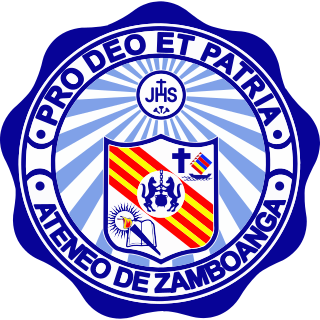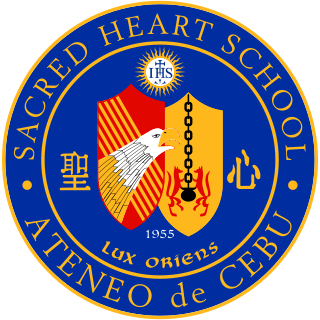
The Katipunan, officially the Kataastaasan Kagalang-galang na Katipunan ng mga Anak ng Bayan and abbreviated as the KKK, was a revolutionary organization founded in 1892 by a group of Filipino nationalists Deodato Arellano, Andrés Bonifacio, Valentin Diaz, Ladislao Diwa, José Dizon, and Teodoro Plata. Its primary objective was achieving independence from the Spanish Empire through an armed revolution. It was formed as a secret society before its eventual discovery by Spanish authorities in August 1896. This discovery led to the start of the Philippine Revolution.

Ateneo de Manila University, also known simply as Ateneo de Manila or Ateneo, is a private, Catholic research university and basic education institution in Quezon City, Philippines. Founded in 1859 by the Jesuits, it is the second-oldest Jesuit-administered institution of higher learning in the Asia-Pacific.
The Church of the Gesù is the Roman Catholic church of the Ateneo de Manila University campus in Quezon City in the Philippines. The landmark was designed by Jose Pedro Recio and Carmelo Casas. The edifice’s massive triangular structure symbolizes the Holy Trinity, as well as the three-fold mission and vision of the school. Its shape and design are also meant to suggest the outstretched arms of the Sacred Heart, and the traditional Filipino bahay kubo. The site has a total area of 10,200 square metres (110,000 sq ft) and seating capacity for 1,000 persons. The church is situated on Sacred Heart Hill, a small hill overlooking Bellarmine Field, believed to be the highest point in barangay Loyola Heights. In its immediate vicinity are the dormitories and the John Pollock Renewal Center. The peak cross and carillon of the church can be seen from Katipunan Avenue, which borders the campus to the west.

Horacio Villamayor de la Costa was a Filipino Jesuit priest, historian and academic. He was the first Filipino Provincial Superior of the Society of Jesus in the Philippines, and a recognized authority in Philippine and Asian culture and history.

The Ateneo de Zamboanga University, also referred to by its acronym AdZU, is a private Catholic coeducational basic and higher education institution run by the Philippine Province of the Society of Jesus in Zamboanga City, Philippines. It is the second oldest Jesuit school in the Philippines. It operates on three campuses.

The Blue Eagle Gym is a gymnasium located in the main campus of the Ateneo de Manila University in Quezon City, Philippines. Unlike most gymnasiums, the basketball court is oriented perpendicular to the orientation of the building.

The Ateneo de Manila University is a private research university in Quezon City, Philippines. Founded in 1859 by the Society of Jesus, the Ateneo is the third-oldest university in the Philippines.

The Ateneo Blue Eagles are the collegiate varsity teams of the Ateneo de Manila University that play in the University Athletic Association of the Philippines (UAAP), the premiere collegiate league in the Philippines. The collegiate women's varsity basketball team is called the Lady Eagles. The Ateneo collegiate men's varsity basketball team was not always called the Blue Eagles. It got the name Blue Eagles when Ateneo adopted the Eagle as its mascot in 1938. Prior to that, from 1914 it was known under different names.

Bienvenido F. NebresS.J. is a Filipino scientist, mathematician, and a Jesuit priest who was the longest-serving university president of the Ateneo de Manila University. He succeeded Joaquin G. Bernas in 1993, and served as University President until 1 June 2011. He currently sits as a member of the board of trustees of Georgetown University, Regis University, St. Edward School Foundation, Inc., the Asian Institute of Management, and other colleges and universities in the Philippines. He is also a member of the board of directors of Philippine Long Distance Telephone Company, and is currently chairman of the Synergeia Foundation. He was also Provincial Superior of the Society of Jesus in the Philippines.
Joaquin G. Bernas SJ was a Jesuit priest, lawyer, college professor and writer who was Dean Emeritus of the Ateneo de Manila Law School in Makati, Philippines. He was a member of the 1986 Constitutional Commission which drafted the 1987 Philippine Constitution.

Sacred Heart School – Ateneo de Cebu (SHS-AdC), formerly known as Sacred Heart School for Boys (SHS-B), is a private, Catholic, Chinese-Filipino college-preparatory, K-12 school run by the Philippine Province of the Society of Jesus in Mandaue City, Philippines. It was established in 1955 with a curriculum that includes a Chinese language course.

The recorded history of the Philippines between 900 and 1565 begins with the creation of the Laguna Copperplate Inscription in 900 and ends with the beginning of Spanish colonization in 1565. The inscription records its date of creation in 822 Saka. The discovery of this document marks the end of the prehistory of the Philippines at 900 AD. During this historical time period, the Philippine archipelago was home to numerous kingdoms and sultanates and was a part of the Indosphere and Sinosphere.

The history of the Philippines from 1565 to 1898 is known as the Spanish colonial period, during which the Philippine Islands were ruled as the Captaincy General of the Philippines within the Spanish East Indies, initially under the Viceroyalty of New Spain, based in Mexico City, until the independence of the Mexican Empire from Spain in 1821. This resulted in direct Spanish control during a period of governmental instability there. The Philippines was under direct royal governance from 1821 to 1898.

The maharlika were the feudal warrior class in ancient Tagalog society in Luzon, the Philippines. They belonged to the lower nobility class similar to the timawa of the Visayan people. In modern Filipino, however, the word has come to refer to aristocrats or to royal nobility, which was actually restricted to the hereditary maginoo class.
The Universidad de San Ignacio was a university in the city of Manila which existed during the Spanish colonial era in the Philippines. It was founded in 1590 and is one of the earliest educational institutions built by Europeans in East Asia when it was established by Spanish Jesuits headed by Fr. Antonio Sedeño, S.J. The school ceased its existence following the expulsion of the Jesuits in the archipelago in 1768.
UAAP Season 76 is the 2013–2014 athletic year of the University Athletic Association of the Philippines. It was hosted by Adamson University with Fr. Maximino D. Rendon, C.M. as president. There were eight universities that competed in fifteen sports with poomsae, a form in the sport of taekwondo now recognized as a regular sport and included in the general championship tally.

UAAP Season 77 is the 2014–15 athletic year of the University Athletic Association of the Philippines (UAAP). The season host is the University of the East with Carmelita Mateo as president. Eight universities are competing in fifteen sports to vie for the general championship. Each sporting event is hosted by a school.

UAAP Season 78 was the 2015–2016 athletic year of the University Athletic Association of the Philippines (UAAP). It opened on September 5, 2015, almost two months after the usual July opening of the league during previous seasons, due to the shift in the academic calendars of four member universities, i.e. Ateneo, La Salle, UP and UST. It was hosted by the University of the Philippines.

Jorella Marie "Ella" de Jesus is a Filipino volleyball player. She was a member of the Ateneo de Manila University's collegiate varsity team from 2011 to 2015, and also of the 2015 Philippines U23 national team. She played for PLDT Home Ultera Fast Hitters as a Libero for the 2015 season.
The Ateneo Blue Eagles are the women's collegiate varsity volleyball team of the Ateneo de Manila University. They compete in the University Athletic Association of the Philippines (UAAP).















